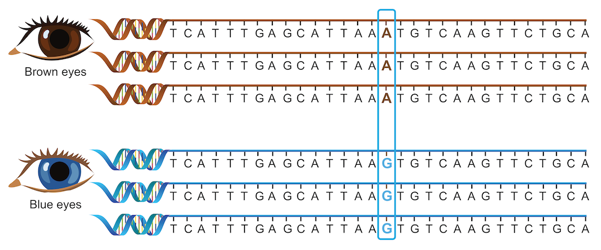
Do all blue eyed people share a common ancestor?
July 28, 2023

- Related Topics:
- Eye color,
- Pigmentation traits,
- Ancestry,
- Population genetics
A curious adult from New York asks:
"Do all blue eyed people share a common ancestor?"
Well, if you go back far enough, all humans share a common ancestor, so the answer is definitely yes!
More usefully, if you’re asking whether all blue-eyed people share a single common blue-eyed ancestor, that’s not quite true — but the majority of them do! Read on to find out more.

What causes blue eyes?
In 2008, scientists made a huge breakthrough in understanding eye color. They found a genetic difference in blue-eyed people, in a gene called OCA2. This genetic difference was almost perfectly correlated with the blue eyes in the study population.1
The OCA2 gene makes a lot of sense as an important part of eye color. It is one of many genes involved in making melanin, the pigment found in skin, hair, and eyes. Brown eyes have a full amount of melanin, while any other eye color has less. This newly-found difference in OCA2 causes less pigment to be made in the eyes.
From this data, scientists were able to label the OCA2 difference as the most common cause of blue eyes.1
Since 2008, scientists have found several exceptions to this rule (more on that below). However, this change is still the primary known contributor to eye color variation. So where did it come from?

Was there a common ancestor?
The next question was whether the OCA2 difference happened just once, in a single blue-eyed ancestor, or if it happened several different times.
To figure this out, the scientists in the 2008 study took a close look at the genetic sequences of the people with blue-eyes. They found that all of the people had exactly the same genetic difference, in exactly the same place. Human DNA is extremely long, with over 3 billion unique positions. The odds that the exact same change happened at the exact same position in a bunch of different people are extremely small. It’s far, far more likely that the mutation only occurred once.
However, that’s not the only piece of evidence. If the mutation came from a common ancestor, then we would expect the ancestor to not only pass down the mutation itself but also the DNA surrounding the mutation. We call these full surrounding regions haplotypes, and they are a very powerful tool to identify shared ancestry.
So if the common ancestor theory is true, then we would expect most blue-eyed people to have the same surrounding DNA at that location. If the mutation arose independently, then we would expect the opposite. As it turns out, the surrounding regions were identical for almost every single individual tested in the 2008 study.1
Those are two strong pieces of evidence that virtually all humans with this OCA2 difference do indeed descend from a common ancestor.
How long ago did the common ancestor live?
While it may seem impossible to determine exactly how long ago a mutation happened, scientists have developed a variety of methods to make this task easier.
The original mutation in OCA2 arose between 6 and 10 thousand years ago in the Black Sea region of Europe.1 Shortly after this time, a large-scale migration occurred from the Black Sea to Northern Europe. Today, most blue-eyed individuals have ancestry from there.
Less pigmentation was a useful trait in the low-sunlight environment of Northern Europe. People with lighter skin can more efficiently absorb sunlight, which is important for making Vitamin D. While lighter-skinned people also sunburn more easily, it was a beneficial trade-off in that region. After a few thousand years of natural selection, lighter skin, fairer hair, and bluer eyes became prominent in this part of the world. Indeed, most people with blue eyes today have some European ancestry.

What about the exceptions?
While the genetic difference in OCA2 is the greatest predictor of blue eyes, scientists have delved more deeply into eye color since the groundbreaking 2008 paper.
For example, a research group found several blue-eyed individuals from Norway who did not follow the established pattern. By analyzing their DNA further, they identified multiple new genetic differences that could also cause blue eyes.2 Another study found that looking at six unique locations — as opposed to just the one in OCA2 — produced the best predictions of eye color.3
Scientists have also found a few other genetic differences — both near OCA2 and in other genes — that have an effect on intermediate colors. After all, not everyone’s eyes are fully blue or fully brown! It is likely that these locations interact with the established OCA2 change to ultimately determine an individual’s final eye color.
Importantly, if someone’s blue eyes had a different cause, it is very unlikely they share the same ancestor as the group with the OCA2 mutation.
The final conclusion
Ultimately, we know that the most common cause of blue eyes is a single genetic difference in OCA2. It’s very likely that all individuals with this difference share a single common ancestor. We can even trace back the mutation to when and where it took place! However, we also know that some blue-eyed people do not follow this pattern. They likely do not share the same common ancestor.
I hope this story has demonstrated the immense power of population genetics in uncovering insights regarding our own species. Pretty cool, right?
Read More:
-
Ask-a-Geneticist article on this from 2013: Is everyone with blue eyes related? How was that trait passed on?
-
Medline: Is eye color determined by genetics?
-
Livescience: More about the 2008 paper on a single blue eyed ancestor

Author: Aman Patel
When this article was published in 2023, Aman was a PhD candidate in the Department of Computer Science, developing Artificial Intelligence approaches to study evolution and gene regulation as part of Anshul Kundaje’s laboratory. He wrote this answer while participating in the Stanford at the Tech program.
 Skip Navigation
Skip Navigation
